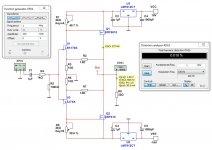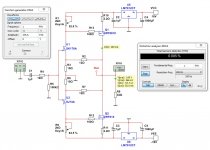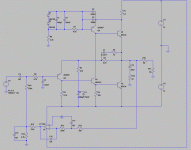This idea is based on the F5 Simplified schematic by Nelson Pass.
As it stands it is for 32 Ohm headphones.
The gain is a bit over 2.
Gain can be adjusted by R2 and R7 for other headphones.
Transformer can be 2x12VAC or possibly 2x15VAC.
The bias is here 227mA Class A and this gives a THD like 0.010%.
As it stands it is for 32 Ohm headphones.
The gain is a bit over 2.
Gain can be adjusted by R2 and R7 for other headphones.
Transformer can be 2x12VAC or possibly 2x15VAC.
The bias is here 227mA Class A and this gives a THD like 0.010%.
Attachments
As it works in Class A, I can see no thermal issues.
If anybody thinks otherwise I welcome adjustments.
What does Nelson Pass think?
If anybody thinks otherwise I welcome adjustments.
What does Nelson Pass think?
Acamini schematics wirh single b+ and is caps on out is quite safeRevison #1
I added Gate and Source resistors.
It turns out that the distortion is even lower at 200mA bias.
THD is now 0.005%
Yes, DC-Servo is an option.
Rod 'ESP' Elliott has an artcle on both non-inverted and inverted DC-Servo.
https://sound-au.com/articles/dc-servo.htm
To play it simple and safe we can always add an output capacitor.
If we look at my circuit I do not think it will be a issue with DC-offset.
Once we adjust for lowest DC-offset it would stay low.
And then we can add headphones with no problem.
Rod 'ESP' Elliott has an artcle on both non-inverted and inverted DC-Servo.
https://sound-au.com/articles/dc-servo.htm
To play it simple and safe we can always add an output capacitor.
If we look at my circuit I do not think it will be a issue with DC-offset.
Once we adjust for lowest DC-offset it would stay low.
And then we can add headphones with no problem.
The question is how fast would it settle after powering on? Even with a large current it will need some time to reach the thermal balance. Another issue might be the turn on thump, which might be dangerous to headphones. We can go with KISS and introduce a delay, but I'm not sure that's going to be enough.Yes, DC-Servo is an option.
Rod 'ESP' Elliott has an artcle on both non-inverted and inverted DC-Servo.
https://sound-au.com/articles/dc-servo.htm
To play it simple and safe we can always add an output capacitor.
If we look at my circuit I do not think it will be a issue with DC-offset.
Once we adjust for lowest DC-offset it would stay low.
And then we can add headphones with no problem.
Nice circuit 🙂
I don't want to add DC servo or delay. Best is to not connect headphone until the amp settles.
I don't want to add DC servo or delay. Best is to not connect headphone until the amp settles.
In 2017 I built the F5 headamp ( https://www.diyaudio.com/community/threads/f5-headamp.271926/ ) in simple form.
It works good and stable without servo.
JFets are 2SK170BL / 2SJ74BL and Fets FQP3P20 / FQP3N30. Source resistors: 3.3Ohm
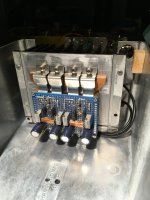
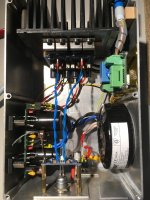
It works good and stable without servo.
JFets are 2SK170BL / 2SJ74BL and Fets FQP3P20 / FQP3N30. Source resistors: 3.3Ohm


This is a similar headphone amplifier.
But it is based on F7 by @Nelson Pass
The Fourier shows it is mainly 2nd harmonics.
Of course it is a CFA amp.


But it is based on F7 by @Nelson Pass
The Fourier shows it is mainly 2nd harmonics.
Of course it is a CFA amp.
Last edited:
https://www.diyaudio.com/community/attachments/f5-ha-v1a-png.475778/
Oh, BTW, the F5 HA was published i March 2015.
If I am not wrong, the F7 was first available a year later, in 2016.
The review at 6moons was in June 2015 ?
And the F7 has positive feedback that the F5 HA does not have :

Cheers,
Patrick
Oh, BTW, the F5 HA was published i March 2015.
If I am not wrong, the F7 was first available a year later, in 2016.
The review at 6moons was in June 2015 ?
And the F7 has positive feedback that the F5 HA does not have :
Cheers,
Patrick
Last edited:
I have added a compensation cap = C9.
After this there is a perfect squarewave.
The internal bandwidth is like 1.6 MHz.

After this there is a perfect squarewave.
The internal bandwidth is like 1.6 MHz.
- Home
- Amplifiers
- Pass Labs
- Simplified F5 as Headphone Amplifier. Easy project.
